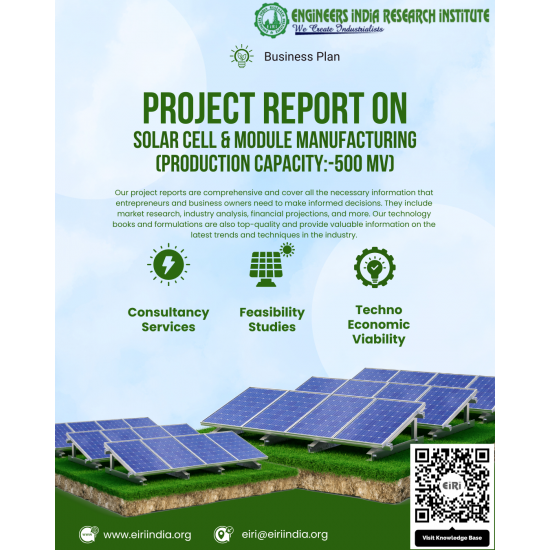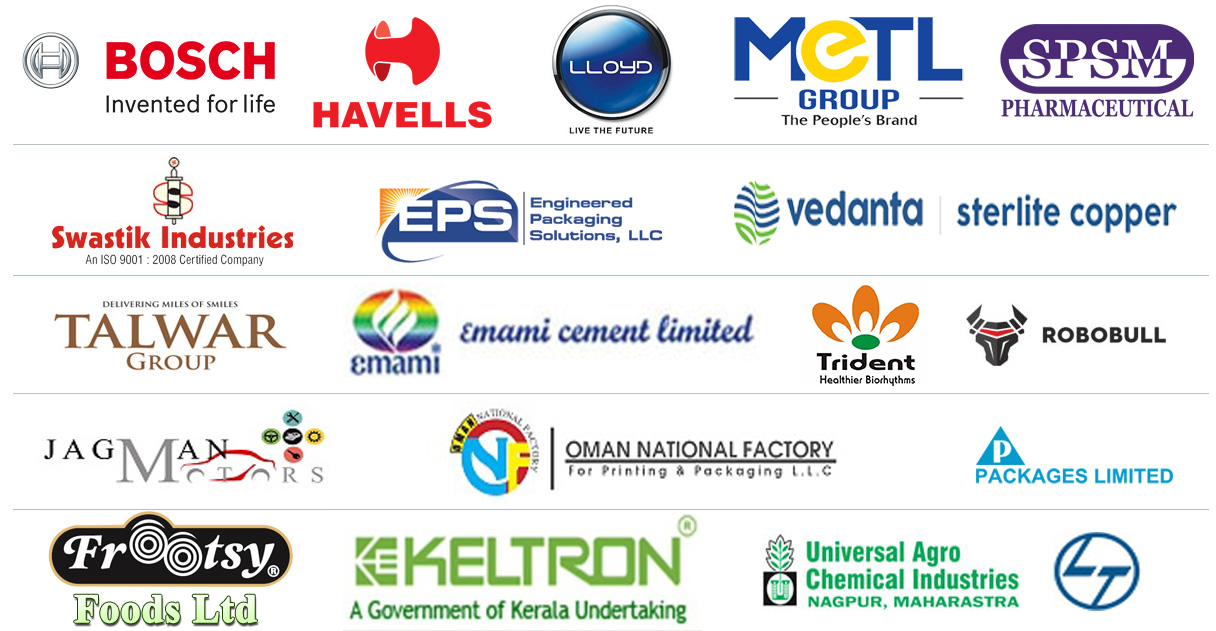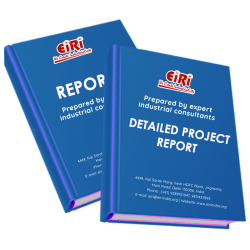SOLAR CELL & MODULE MANUFACTURING (PRODUCTION CAPACITY:-500 MV)

- More than 45 years of experience
- Managed by expert industrial consultants
- ISO 9001-2015 Certified
- Registered under MSME, UAM No: DL01E0012000
- 24/5 Research Support
Get your quesries resolved from an industry expert. Ask your queries before report or book purchase. - Custom Research Service
Speak to the our consultant to design an exclusive study to serve your research needs. - Quality Assurance
All reports are prepared by highly qualified consultants & verified by a panel of experts. - Information Security
Your personal & confidential information is safe & secure.
SOLAR CELL & MODULE MANUFACTURING (PRODUCTION CAPACITY:-500 MV)
[EIRI/EDPR/4805] J.C: 3026)
A solar cell (also known as a photovoltaic cell or PV cell) is defined as an electrical device that converts light energy into electrical energy through the photovoltaic effect. A solar cell is basically a p-n junction diode. Solar cells are a form of photoelectric cell, defined as a device whose electrical characteristics – such as current, voltage, or resistance – vary when exposed to light.
Individual solar cells can be combined to form modules commonly known as solar panels. The common single junction silicon solar cell can produce a maximum open-circuit voltage of approximately 0.5 to 0.6 volts. By itself this isn’t much – but remember these solar cells are tiny. When combined into a large solar panel, considerable amounts of renewable energy can be generated.
PV Module or Solar PV Module is an assembly of photovoltaic (PV) cells, also known as solar cells. To achieve a required voltage and current, a group of PV modules (also called PV panels) are wired into large array that called PV array. A PV module is the essential component of any PV system that converts sunlight directly into direct current (DC) electricity. PV modules can be wired together in series and/or parallel to deliver voltage and current in a particular system requires.
PV is emerging as a major power resource, steadily becoming more affordable and proving to be more reliable than utilities. Photovoltaic power promises a brighter, cleaner future for our children.
Using the technology we have today we could equal the entire electric production of the United States with photovoltaic power plants using only about 12,000 square miles.
COST ESTIMATION
Plant Capacity 5977 Pieces/Day
Land & Building (16000 sq.mt.) Rs. 9.80 Cr
Plant & Machinery Rs. 60.90 Cr
Working Capital for 1 Month Rs. 74.85 Cr
Total Capital Investment Rs. 148.80 Cr
Rate of Return 68%
Break Even Point 26%
CONTENT
- INTRODUCTION
- CELLS MODULES AND ARRAYS
- PHOTOVOLTAIC CELL
- PHOTOVOLTAIC MODULES
- COMMERCIAL PRODUCTION TECHNOLOGIES FOR PV
- SINGLE CRYSTALLINE
- POLYCRYSTALLINE OR MULTICRYSTALLINE
- AMORPHOUS OR THIN FILM
- PHOTOVOLTAIC PANELS
- PHOTOVOLTAIC ARRAY
- PROJECT LOCATION
- LUNAWADA
- MAP
- TRANSPORTATION
- Near By major Cities
- Near By Air Ports
- Near By Tourist Places
- Near By Local Cities
- Near By Districts
- Near By RailWay Station
- HISTORY OF PHOTOVOLTIC CELLS
- TYPES OF PV MODULE
- CRYSTALLINE SILICON PV MODULE
- SINGLE CRYSTALINE (MONO-CRYSTALLINE)
- CONSTRUCTION
- TECHNICAL SPECIFICATION
- ADVANTAGES OF MONOCRYSTALLINE PV MODULE
- DISADVANTAGES
- APPLICATIONS OF MONOCRYSTALLINE SOLAR PANELS
- POLY-CRYSTALLINE (MULTI CRYSTALLINE)
- CONSTRUCTION
- ADVANTAGES OF POLYCRYSTALLINE PV MODULE
- DISADVANTAGES OF POLYCRYSTALLINE SOLAR PANELS
- CONSTRUCTION OF PV MODULE
- THE 6 MAIN COMPONENTS OF A SOLAR PANEL
- PV CELLS
- A Monocrystalline solar cell
- Glass
- Frame
- EVA Film
- Back sheet
- Junction Box
- Bypass diodes
- Number of Cells in Module
- PROS & CONS OF PV
- COMPLETE PHOTOVOLTAIC-BASED ELECTRICAL SYSTEMS
- PHOTOVOLTAIC MODULE PERFORMANCE
- PHOTOVOLTAIC APPLICATIONS
- PHOTOVOLTAIC BENEFITS
- SOLAR CELL I-V CHARACTERISTIC
- SOLAR CELL I-V CHARACTERISTIC AND THE SOLAR CELL I-V CURVE
- SOLAR CELL I-V CHARACTERISTIC CURVE
- THE ELECTRICAL CHARACTERISTICS OF A PHOTOVOLTAIC ARRAY
- Solar Array Parameters
- Example of I-V Curve and Ratings of a 12 V Solar (PV) Panel
- IV Curve
- Ideal Solar Cell
- Ideal Solar Cell (simplified)
- EFFECT OF TEMPERATURE
- THE AFFECTS OF IRRADIANCE
- EFFECT OF LIGHT INTENSITY
- CONCENTRATORS
- LOW LIGHT INTENSITY
- LINE CAPACITY
- SOLAR PV MODULE SPECIFICATION
- (A) MECHANICAL SPECIFICATION
- 1. Solar Cell Type
- 2. Cell Dimension (in inches/mm.)
- 3. Module Dimension (in inches/mm.)
- 4. Module Weight (in kgs./lbs.)
- 5. Glazing or front Glass
- 6. Frame
- 7. Output Cables
- 8. Junction Box
- (B) ELECTRICAL SPECIFICATION
- 1. Peak Power (W)
- 2. Optimum operating Voltage
- 3. Optimum operating current
- 4. Open Circuit Voltage
- 5. Short Circuit Current
- 7. Module Efficiency
- 8. Operating Temperature
- 9. Max. Series Fuse Rating
- 10. Power Tolerance
- 11. Parameters defined under NOCT
- 12. Temperature Coefficients
- APPLICATIONS OF POLYCRYSTALLINE SOLAR PANELS
- ADVANTAGES OF PV PANNEL
- DISADVANTAGES OF PV PANNEL
- USES AND APPLICATION OF PV POWER PLANT
- APPLICATIONS OF MONOCRYSTALLINE SOLAR PANELS
- APPLICATIONS OF POLYCRYSTALLINE SOLAR PANELS
- Agriculture
- Industry, Telecommunications & Public Services
- Health
- Residential
- B.I.S. SPECIFICATION
- HEADQUARTERS
- SALES OUTLETS ADDRESS
- TELEPHONE NO/FAX/E-MAIL
- PROCESS FLOW CHART FOR SOLAR PANEL
- FABRICATION PROCESS OF MONOCRYSTALLINE SOLAR PV MODULE
- A. SOLAR CELL
- B. EVA (ETHYLENE VINYL ACETATE)
- Encapsulant’s (EVA) requirements
- C. BACKSHEET
- Requirements of rear surface
- D. GLASS
- Requirements
- E. JUNCTION BOX WITH BYPASS DIODES AND CONNECTING CABLES JUNCTION
- Cables Junction box consists of the following
- F. CONNECTING RIBBON TWO TYPES OF CONNECTING RIBBON ARE
- G. SILICONE SEALANT
- Sealant
- H. SHORT AND LONG FRAMES (BACKBONE OF THE MODULE STRUCTURE)
- MODULE ASSEMBLY STEPS
- MARKET POSITION
- PV MODULES MARKET – INDIA
- RISING IMPORTS
- DOMESTIC INDUSTRY WOES
- WAY FORWARD
- RISEN ENERGY
- WAAREE
- ZNSHINE
- VIKRAM SOLAR
- ADANI
- TRINA SOLAR
- RENESOLA
- JINKOSOLAR
- LONGI SOLAR
- CANADIAN SOLAR
- GLOBAL MARKET
- TECHNOLOGY INSIGHTS
- APPLICATION INSIGHTS
- GRID TYPE INSIGHTS
- REGIONAL INSIGHTS
- KEY COMPANIES & MARKET SHARE INSIGHTS
- PV PRODUCTION LINE
- M-01 AUTOMATIC GLASS LOADING
- Function
- Description
- Main features
- Features GLL0205-2
- M-02 AUTOMATIC ENCAPSULANT CUTTING AND LOADING
- Function
- Description
- Features FCM0304-2
- M-03 AUTOMATIC TEMPLATE LOADING
- Function
- Description
- Features FCM0305-1
- M-04 INSPECTION TABLE
- Function
- Characteristics
- Features ICB2205-1
- Advantages
- M-05 TABBER AND STRINGER MTS-3000
- Function
- Description
- Highlights
- Main Features
- Cell parameters
- Tabs
- Strings
- Tabbing & Stringing
- Performance features
- System dimensions
- System control & software
- LIST OF EQUIPMENT INCLUDED:
- M-06 LAY-UP SYSTEM
- Function
- Highlights
- Features LUS2200-1
- M-07 MIRROR INSPECTION TABLE
- Function
- Characteristics
- Features ICB2200-1
- Advantages
- M-08 AUTOMATIC BUSSING IC100 (3 HEADS
- Function
- Description
- Advantages
- Features ICB2001-1
- M-9 INTERCONNECTION CHECKING + LABEL PLACING
- Function
- Characteristics
- Features ICB2207-1
- Advantages
- M-10 EL INSPECTION
- Function
- Characteristics
- Features EL MA
- M-11 AUTOMATIC FOIL CUTTING AND LOADING
- Function
- Description
- Features FCM0307-2
- M-12 BUFFER
- Function
- Characteristics
- Advantages
- Features BUF3501-1
- M-13 LAMINATOR
- Function
- Description
- Advantages of our Laminators
- Features LAM3024-1
- M-14 AUTOMATIC EDGE TRIMMING
- Function
- Characteristics
- Advantages
- Process description
- Features ETM3604-2
- M15 AUTOMATIC OPTICAL INSPECTION
- Function
- Characteristics
- Advantages
- Features VT5007-1
- Optical inspection
- M-16 AUTOMATIC FRAMING UNIT
- Function
- Characteristics
- Features FR4200-2
- Auto frame feeder (OPTIONAL)
- M-17 JBOX WORKING TABLES
- Function
- Characteristics
- Advantages
- M-18 AUTOMATIC JBOX POTTING MACHINE
- Function
- Characteristics
- Features JBX3709-1
- M-19 JBOX POTTING DISPENSING MACHINE
- Function
- Characteristics
- Features JBX3707-1
- M-20 JBOX SILICONE DISPENSING MACHINE
- Function
- Characteristics
- Advantages
- Features JBX3707-1
- M-21 CURING LINE
- Function
- Characteristics
- Advantages
- Features CUR 6001-2
- M-22 MODULE TESTING STATION
- Function
- Main characteristics
- Features IVT5006-1 ENDEAS QUICKSUN 600
- M-23 AUTOMATIC MODULE SORTING
- Function
- Advantages
- Features SOR6102-1
- M-24 AUTOMATIC GLASS LOADING
- Function
- Description
- Main features
- Features GLL0205-1
- M-25 SECOND GLASS LOADING
- Function
- Characteristics
- Advantages
- Features SGL0206-1
- M-26 AUTOMATIC MODULE SORTING FOR GG (INSTEAD OF M-23)
- Function
- Characteristics
- Advantages
- Features SOR6102-1
- M-27 AUTO CELL LASER CUTTING MACHINE (OPTIONAL)
- Function
- Highlights
- Precious separation
- Low consumption
- Features: GDS 50
- Offline Equipment Quantity
- ACCESSORIES
- A-01 CELL TESTER
- Function
- Characteristics
- Advantages
- Features CLT0102-1
- ASSEMBLY LAYOUT
- LINE LAYOUT (PROPOSED)
- PLANT LAYOUT
- MANUFACTURERS/SUPPLIERS OF SOLAR PV MODULE
- RAW MATERIAL SUPPLIERS OF SOLAR CELL
- SUPPLIERS OF EVA ENCAPSULATE
- SUPPLIERS OF ALUMINIUM FRAMER
- SUPPLIERS OF JUNCTION BOX
- SUPPLIERS OF SILICON GEL
- SUPPLIERS OF THERMO PLASTIC BACK SHEET
- MACHINERY SUPPLIERS COMPELETE PRODUCTION PLANT
- SUPPLIERS OF POWER TRANSFORMERS
- SUPPLIERS OF ELECTRICAL MEASURING INSTRUMENTS
- MACHINERY PHOTOGRAPHS
- AUTOMATIC GLASS LOADING
- AUTOMATIC ENCAPSULANT CUTTING AND LOADING
- AUTOMATIC TEMPLATE LOADING
- INSPECTION TABLE
- TABBER AND STRINGER MTS-3000
- MIRROR INSPECTION TABLE
- AUTOMATIC BUSSING IC100 (3 HEADS)
- INTERCONNECTION CHECKING + LABEL PLACING
- AUTOMATIC FOIL CUTTING AND LOADING
- BUFFER
- LAMINATOR
- AUTOMATIC EDGE TRIMMING
- AUTOMATIC OPTICAL INSPECTION
- AUTOMATIC FRAMING UNIT
- JBOX WORKING TABLES
- JBOX POTTING DISPENSING MACHINE
- JBOX SILICONE DISPENSING MACHINE
- CURING LINE
- MODULE TESTING STATION
- AUTOMATIC MODULE SORTING
- AUTOMATIC GLASS LOADING
- AUTOMATIC MODULE SORTING FOR GG (INSTEAD OF M-23)
- AUTO CELL LASER CUTTING MACHINE (OPTIONAL)
- CELL TESTER
- PRODUCT PHOTOGRAPHS
APPENDIX – A:
- 01. PLANT ECONOMICS
- 02. LAND & BUILDING
- 03. PLANT AND MACHINERY
- 04. OTHER FIXED ASSETS
- 05. FIXED CAPITAL
- 06. RAW MATERIAL
- 07. SALARY AND WAGES
- 08. UTILITIES AND OVERHEADS
- 09. TOTAL WORKING CAPITAL
- 10. TOTAL CAPITAL INVESTMENT
- 11. COST OF PRODUCTION
- 12. TURN OVER/ANNUM
- 13. BREAK EVEN POINT
- 14. RESOURCES FOR FINANCE
- 15. INSTALMENT PAYABLE IN 5 YEARS
- 16. DEPRECIATION CHART FOR 5 YEARS
- 17. PROFIT ANALYSIS FOR 5 YEARS
- 18. PROJECTED BALANCE SHEET FOR (5-10 YEARS)
How to Make Project Report?
Detailed Project Report (DPR) includes Present Market Position and Expected Future Demand, Technology, Manufacturing Process, Investment Opportunity, Plant Economics and Project Financials. comprehensive analysis from industry covering detailed reporting and evaluates the position of the industry by providing insights to the SWOT analysis of the industry.
Each report include Plant Capacity, requirement of Land & Building, Plant & Machinery, Flow Sheet Diagram, Raw Materials detail with suppliers list, Total Capital Investment along with detailed calculation on Rate of Return, Break-Even Analysis and Profitability Analysis. The report also provides a birds eye view of the global industry with details on projected market size and then progresses to evaluate the industry in detail.
We can prepare detailed project report on any industry as per your requirement.
We can also modify the project capacity and project cost as per your requirement. If you are planning to start a business, contact us today.
Detailed Project Report (DPR) gives you access to decisive data such as:
- Market growth drivers
- Factors limiting market growth
- Current market trends
- Market structure
- Key highlights
Overview of key market forces propelling and restraining market growth:
- Up-to-date analyses of market trends and technological improvements
- Pin-point analyses of market competition dynamics to offer you a competitive edge major competitors
- An array of graphics, BEP analysis of major industry segments
- Detailed analyses of industry trends
- A well-defined technological growth with an impact-analysis
- A clear understanding of the competitive landscape and key product segments
Need Customized Project Report?
- Ask for FREE project related details with our consultant/industry expert.
- Share your specific research requirements for customized project report.
- Request for due diligence and consumer centric studies.
- Still haven't found what you're looking for? Speak to our Custom Research Team
About Engineers India Research Institute:
Note: We can also prepare project report on any subject based on your requirement and country. If you need, we can modify the project capacity and project cost based on your requirement.
Our Clients

Our Approach
- Our research reports comprehensively cover Indian markets (can be modified as per your country), present investigation, standpoint and gauge for a time of five years*.
- The market conjectures are produced on the premise of optional research and are cross-accepted through associations with the business players
- We use dependable wellsprings of data and databases. What's more, data from such sources is handled by us and incorporated into the report
Why buy EIRI reports?
- Our project reports include detailed analysis that help to get industry Present Market Position and Expected Future Demand.
- Offer real analysis driving variables for the business and most recent business sector patterns in the business
- This report comprehends the present status of the business by clarifying a complete SWOT examination and investigation of the interest supply circumstance
- Report gives investigation and top to bottom money related correlation of real players/competitors
- The report gives gauges of key parameters which foresees the business execution






















